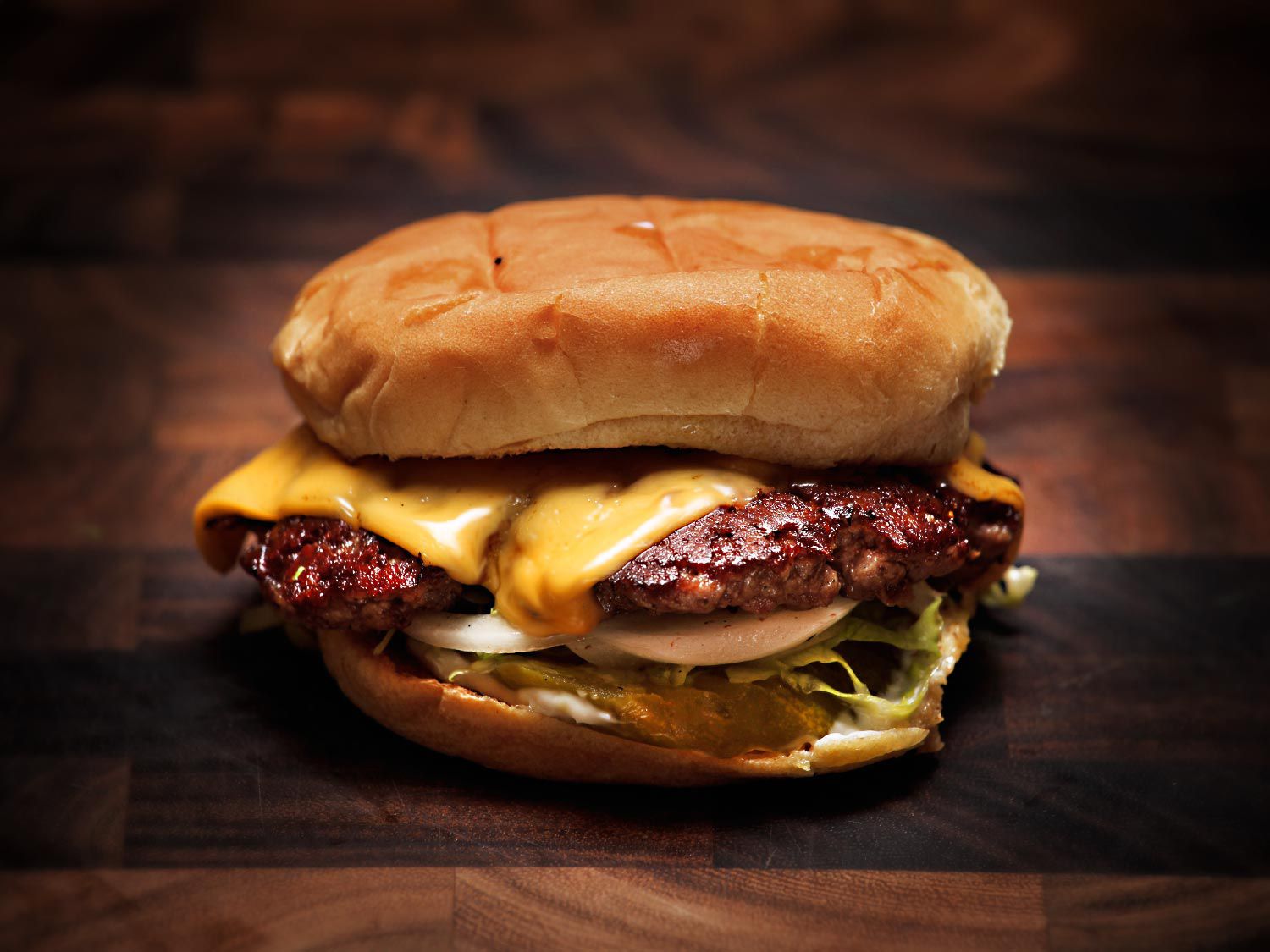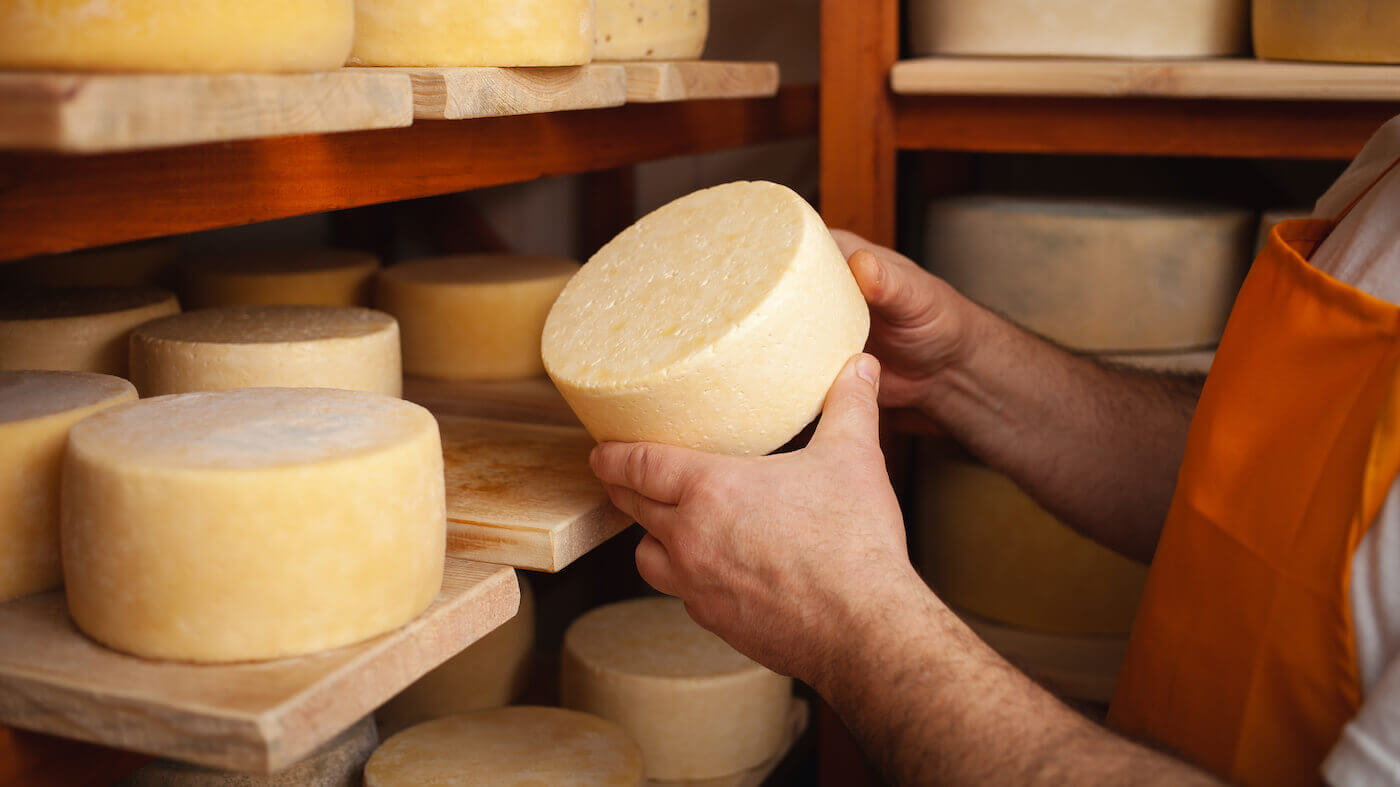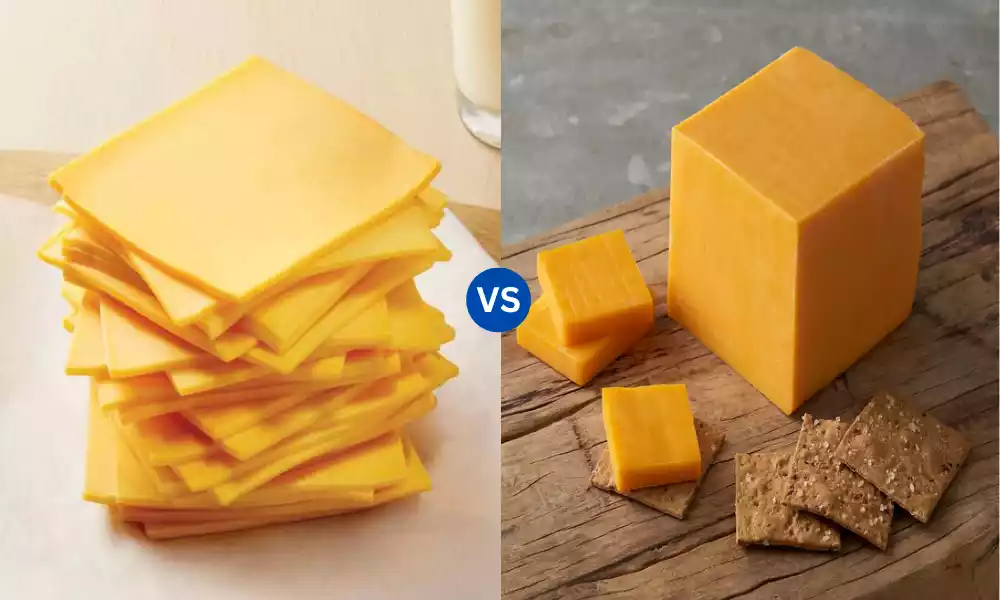American cheese and Cheddar cheese are both popular varieties of cheese, each with its unique characteristics and origins. American cheese, known for its smooth texture and mild flavor, is a processed cheese product that often contains a blend of milk, milk fats, and solids, with other fats and whey protein concentrate. It melts well and is commonly used in sandwiches and burgers.
On the other hand, Cheddar cheese, which originated in the English village of Cheddar in Somerset, is a natural, hard cheese with a sharper taste. It’s made from cow’s milk and is aged for varying lengths of time to develop its distinct flavor and texture.
Cheddar is versatile, used in everything from sandwiches to soufflés, and is appreciated for its depth of flavor and firmness. Both slices of cheese hold significant places in culinary traditions, with American cheese being a staple in American cuisine, while Cheddar maintains a longstanding heritage in British and international kitchens.
Definition of American Cheese
American cheese is a type of processed cheese. It originated in the United States and is known for its mild flavor and smooth, creamy texture. This cheese is typically made from a blend of cheeses (often including Cheddar and Colby) and other ingredients such as milk, whey, emulsifiers, and preservatives.

The result is a product that has a uniform texture and melts easily, making it a popular choice for sandwiches, burgers, and grilled cheese. Unlike traditional cheeses that are aged and have a more complex flavor profile, American cheese is designed for convenience and versatility, often available in pre-sliced form and with a longer shelf life than natural cheeses. Its characteristics make it a staple in American cuisine, especially in fast food and casual dining.
Definition of Cheddar Cheese
Cheddar cheese is a natural, hard cheese that originated in the village of Cheddar in Somerset, England. It is one of the most popular and widely consumed cheeses in the world. Cheddar is made from cow’s milk and is known for its firm texture and deep, rich taste, which can range from mild to extra sharp depending on the aging process. The aging period can vary from a few months to several years, with longer aging resulting in a more intense flavor and crumblier texture.

The cheese-making process involves cheddaring, a unique step where the curd is cut into cubes, stacked, and then turned repeatedly, which contributes to its characteristic texture and flavor. Cheddar’s color ranges from white to deep orange, with the latter often achieved through the addition of annatto, a natural coloring.
Cheddar is highly versatile, used in a variety of dishes from simple sandwiches and cheese platters to complex culinary preparations like soufflés and sauces. Its popularity and production have spread globally, with numerous countries producing their versions of Cheddar cheese.
Differences of American Cheese vs Cheddar Cheese
American cheese and Cheddar cheese, while both popular, have several key differences:
- Origin and History:
- American Cheese: Originated in the United States, it’s a modern invention, a type of processed cheese.
- Cheddar Cheese: Originates from the village of Cheddar in Somerset, England, with a history dating back to the 12th century.
- Production and Ingredients:
- American Cheese: Made from a blend of cheeses (like Cheddar and Colby) and other ingredients such as milk, whey, emulsifiers, and preservatives. It’s processed for uniformity and longer shelf life.
- Cheddar Cheese: Made from cow’s milk, involving a unique process called cheddaring, which gives it a distinct texture and flavor. It’s a natural cheese without added preservatives.
- Texture and Flavor:
- American Cheese: Known for its smooth, creamy texture and mild flavor. It melts evenly, making it a popular choice for cooking.
- Cheddar Cheese: Has a range of textures from smooth to crumbly, depending on age. The flavor varies from mild to extra sharp, again depending on the aging process.
- Aging Process:
- American Cheese: Generally, does not undergo an aging process.
- Cheddar Cheese: Aged for various periods, from a few months to several years. The aging process enhances its flavor and texture.
- Culinary Uses:
- American Cheese: Widely used in sandwiches, burgers, and as a melting cheese due to its consistent reliability.
- Cheddar Cheese: More versatile in use, ranging from sandwiches to soufflés, gratins, and cheese boards. The flavor profile allows it to be used in both cooking and as a table cheese.
- Color:
- American Cheese: Often a consistent orange-yellow color.
- Cheddar Cheese: Varies from white to deep orange; the orange color in some cheddars is from the addition of annatto.
- Cultural and Culinary Significance:
- American Cheese: A staple in American cuisine, particularly in fast food and casual dining.
- Cheddar Cheese: Has a rich heritage in British cuisine and is popular worldwide, reflecting traditional cheese-making practices.
American cheese is a processed product known for its convenience and reliability, while Cheddar is a natural, aged cheese celebrated for its depth of flavor and versatility.
How American Cheese is Made
The process of making American cheese involves several steps, focusing on creating a product that is uniform in taste and texture, and has a longer shelf life compared to natural cheeses like Cheddar.
Here’s an overview of how American cheese is made:
- Selecting the Base Cheeses: American cheese is typically made from a blend of cheeses, most commonly Cheddar and Colby. These cheeses are chosen for their flavor and melting properties.
- Melting the Cheeses: The selected cheeses are melted together. This melting process helps in combining the different flavors and textures into a uniform mixture.
- Adding Emulsifiers: Emulsifiers, such as sodium citrate or sodium phosphate, are added during the melting process. These emulsifiers help maintain the smooth texture of the cheese and prevent the separation of fats and proteins.
- Incorporating Additional Ingredients: Other ingredients like milk, whey, cream, water, salt, artificial color (like annatto for the orange color), and preservatives are added. These ingredients contribute to the flavor, texture, and shelf life of the cheese.
- Blending and Heating: The mixture is then blended and heated. This step ensures that all the ingredients are thoroughly combined and that the cheese has a uniform consistency.
- Cooling and Forming: After heating, the cheese is cooled and formed into blocks, slices, or other shapes. During this process, the cheese solidifies into its final form, which is easy to slice and melt.
- Packaging: The cheese is then packaged, either in individual slices, wrapped blocks, or large industrial-sized packs. The packaging is designed to preserve the freshness and prevent contamination.
- Quality Checks and Storage: Before distribution, the cheese undergoes quality checks to ensure it meets the required standards. It is then stored in a controlled environment to maintain its quality until it reaches the consumer.
American cheese is known for its consistent quality, reliability, and extended shelf life, making it a popular choice for various culinary applications, especially in fast food and casual dining.
How Cheddar Cheese is Made
The making of Cheddar cheese is a process steeped in tradition, involving several steps that contribute to its distinct flavor and texture.
Here’s an overview of how Cheddar cheese is typically made:
- Milk Preparation: The process starts with high-quality cow’s milk. The milk is pasteurized to kill any harmful bacteria and then cooled to the appropriate temperature for cheese making.
- Cultures and Rennet Addition: Starter cultures, which are specific bacteria, are added to the milk to begin the fermentation process. These bacteria help in acidifying the milk. Then, rennet, an enzyme, is added to coagulate the milk, turning it into curds and whey.
- Cutting the Curd: The solid curds are cut into smaller pieces, allowing whey, the liquid part, to separate from the curds. The size of the curd pieces can affect the cheese’s final texture.
- Cooking and Stirring: The curds are gently cooked and stirred. This process expels more whey from the curds and influences the final texture and moisture content of the cheese.
- Cheddaring: This unique step involves the curds being stacked and turned repeatedly. This process, called cheddaring, gives the cheese its name and contributes to its firm texture and flavor. The curds become more acidic and firmer during this phase.
- Milling and Salting: After cheddaring, the curds are milled or cut into small pieces and salted. Salt adds flavor and acts as a preservative.
- Pressing and Molding: The salted curds are then placed into molds and pressed to expel any remaining whey and shape the cheese. The pressure applied also influences the texture of the cheese.
- Aging (Maturation): The cheese is then aged, sometimes for several months to several years. During aging, the cheese develops its characteristic flavor and texture. The environment in which the cheese is aged, including temperature and humidity, plays a crucial role in this process.
- Quality Control and Packaging: After reaching the desired age, the cheese is tested for quality and then packaged for sale. The packaging protects the cheese and preserves its flavor.
Each step in the process of making Cheddar cheese is crucial in determining its final flavor, texture, and quality. Cheddar cheese varies from mild to sharp in flavor and from creamy to crumbly in texture, depending on the length and conditions of the aging process.
Popular Uses in Cuisine
American cheese and Cheddar cheese, due to their distinct characteristics, find varied uses in cuisine:
American Cheese
- Burgers and Sandwiches: Its excellent melting properties make American cheese a favorite for cheeseburgers and grilled cheese sandwiches.
- Comfort Foods: Commonly used in comfort food dishes like macaroni and cheese, nachos, and cheese dips because of its smooth melt and mild flavor.
- Breakfast Dishes: Often used in breakfast sandwiches, omelets, and scrambled eggs for a creamy texture.
- Snacks and Quick Meals: Suitable for snacks like cheese crackers and quick meals like cheese dogs.
- Casseroles and Baked Dishes: Used in various casseroles and baked dishes where a creamy, uniform cheese texture is desired.
Cheddar Cheese
- Culinary Dishes: Cheddar, especially aged varieties, is used in sophisticated culinary dishes, lending a bold flavor to sauces, soups, and gratins.
- Cheese Boards and Pairings: Often featured on cheese boards, paired with fruits, nuts, and wines. Its range from mild to sharp flavors caters to diverse palates.
- Baking: Used in baking savory items like cheese scones, bread, and biscuits.
- Grating Over Dishes: Aged Cheddar is often grated over dishes like pasta, salads, and tacos for an added flavor boost.
- Comfort Foods: Like American cheese, Cheddar is also used in comfort foods such as macaroni and cheese, but it provides a more pronounced flavor.
- Stuffing and Toppings: Ideal for stuffing meats or as a topping in baked potatoes and vegetables.
American cheese is often chosen for its reliability and mild taste, making it a staple in fast-food and casual dining, while Cheddar’s versatility and range of flavors make it a popular choice in both everyday cooking and gourmet cuisine.
Cultural Significance
The cultural significance of American cheese and Cheddar cheese is deeply rooted in their respective histories and culinary traditions:
American Cheese
- Symbol of Convenience and Innovation: American cheese reflects the American ethos of convenience and innovation. Developed in the early 20th century, it became popular due to its long shelf life and ease of use.
- Icon of American Fast Food: It’s closely associated with the rise of the fast-food industry in the United States. Its presence in burgers and sandwiches makes it a staple in American casual dining.
- Comfort Food: American cheese is often linked with nostalgic and comfort foods, evoking memories of childhood and home cooking for many people in the U.S.
- Cultural Debates: There are cultural debates surrounding American cheese, especially among food enthusiasts, regarding its authenticity and nutritional value compared to natural cheeses.
Cheddar Cheese
- British Heritage: Originating from the English village of Cheddar, it represents a significant part of British culinary tradition and cheese-making heritage.
- Global Popularity: Cheddar cheese has become a global phenomenon, enjoyed in various forms across many cultures. Its versatility and range of flavors have made it a favorite worldwide.
- Artisanal and Heritage Value: In its traditional form, particularly when aged and produced using time-honored methods, Cheddar is valued for its artisanal quality and heritage.
- Culinary Flexibility: The variety in flavors and aging of Cheddar cheese means it plays a significant role in both everyday and gourmet cuisine, reflecting a broad cultural appeal.
- Symbol of Regional Identity: For the region of Somerset, England, and other areas known for producing high-quality Cheddar, the cheese is a symbol of regional identity and pride.
American cheese and Cheddar cheese, despite their contrasting characteristics, hold significant places in their respective cultures. American cheese is a product of modern culinary trends and convenience, whereas Cheddar cheese is steeped in tradition and artisanal cheese-making practices.
Health and Diet Considerations
When considering American cheese and Cheddar cheese in the context of health and diet, several factors are:
American Cheese
- Processed Nature: Being a processed product, American cheese typically contains additives like emulsifiers and preservatives. These additives may not suit everyone, especially those with sensitivities to certain food additives.
- Lower in Fat and Calories (Sometimes): Some varieties of American cheese are lower in fat and calories compared to natural cheeses, which can be beneficial for calorie-conscious diets.
- Sodium and Saturated Fat: It often contains high levels of sodium and saturated fats, which should be consumed in moderation, particularly for individuals with heart disease or high blood pressure.
- Calcium and Protein: Like most cheeses, it provides a source of calcium and protein, which are essential for bone and muscle health.
Cheddar Cheese
- Natural Cheese: As a natural cheese, Cheddar is free from the additives found in processed cheeses. However, its nutritional content varies depending on the aging and production process.
- Higher in Saturated Fat: Cheddar, especially aged varieties, can be higher in saturated fat, which should be consumed cautiously by individuals with heart health concerns.
- Rich in Nutrients: It is a good source of essential nutrients such as calcium, protein, phosphorus, and vitamin A.
- Caloric Content: Cheddar is calorie-dense, so portion control is essential for those monitoring their calorie intake.
- Lactose Content: Aged Cheddar has lower lactose content, which might be easier to digest for those with lactose intolerance.
General Considerations
- Moderation is Key: Cheese can be part of a balanced diet when consumed in moderation.
- Variety: Opting for reduced-fat or low-sodium versions can be a healthier choice.
- Dietary Restrictions: Those with dietary restrictions should consider lactose content, fat content, and the presence of additives.
- Allergic Considerations: Individuals with dairy allergies should avoid both types of cheese.
American cheese and Cheddar cheese can be included in a diet, but it’s important to consider their nutritional profiles, especially about individual health concerns and dietary needs. As with all foods, moderation and balance are crucial.
Similarities between American cheese and Cheddar cheese
American cheese and Cheddar cheese, despite their differences, share several similarities:
- Base Ingredient: Both are primarily made from cow’s milk, serving as the foundational ingredient.
- Versatility in Cooking: They are both versatile in culinary uses, often used in a variety of dishes from sandwiches and burgers to casseroles and sauces.
- Melting Properties: American cheese is known for its excellent melting qualities, and Cheddar, especially the younger or medium-aged varieties, also melts well, making them both popular choices for cooked dishes that require a smooth, creamy cheese texture.
- Popular in Western Cuisine: Both cheeses are staples in Western cuisine, particularly in American and British food cultures.
- Nutritional Content: They provide essential nutrients like calcium and protein, contributing to the nutritional value of diets that include dairy products.
- Flavor Profile: While their flavors differ, both have a distinct taste that is loved by many – American cheese for its mild and creamy flavor, and Cheddar for its depth and range from mild to sharp.
These similarities underline their appeal and widespread use in various culinary contexts, despite their distinct origins and production processes.
Final Opinion
American cheese and Cheddar cheese represent two distinct facets of the cheese world. American cheese, a product of modern food processing, is celebrated for its convenience and reliability, making it a staple in fast food and American comfort dishes.
Cheddar cheese, with its deep roots in English tradition, is revered for its rich flavor and versatility, playing a significant role in both everyday and gourmet cuisines globally.

